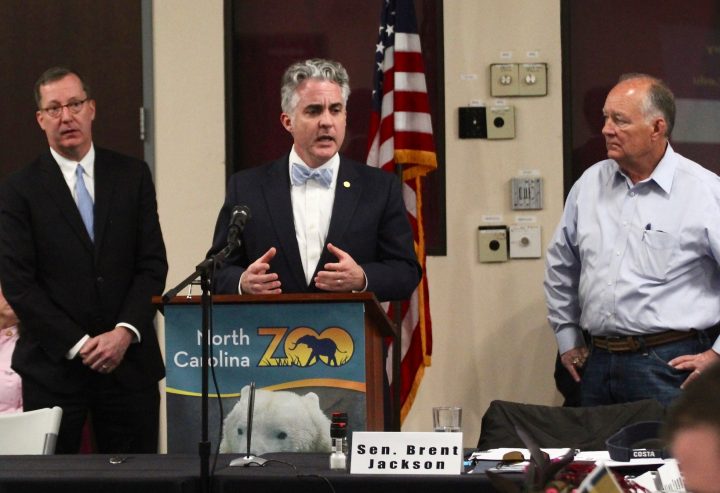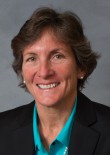
This is the first in a two-part report on the North Carolina Policy Collaboratory’s work.
CHAPEL HILL – After a startup year mixed with scrutiny and budget uncertainty, the North Carolina Policy Collaboratory is now in full stride in its second year as a public-private research grant conduit. But where the environmental and natural resources study center fits in the broader process of policy making is still a work in progress.
Supporter Spotlight
“We really see the collaboratory almost as an in-house NGO, a grants-making organization,”
Brad Ives, Director N.C. Policy Collaboratory
Compiling GenX and emerging contaminants, studies on filtering systems, inexpensive home test kits for drinking water contaminants and the effectiveness of floodplain buyouts are among the latest round of collaboratory studies.
Brad Ives, the University of North Carolina’s associate vice chancellor for campus enterprises who also serves as collaboratory director, said that after getting organized and putting processes in place, the organization can now focus on its main mission.
“We really see the collaboratory almost as an in-house NGO, a grants-making organization,” he said, using the acronym for non-governmental organizations.
A Shaky Start
Much of the collaboratory’s first year was dedicated to getting the organization established while fulfilling legislative assignments for studies and analyses. Studies already assigned by the North Carolina General Assembly range from marketing programs for an “oyster trail,” which would highlight the state’s oyster heritage, to a detailed examination of water quality and regulation of nutrients in the Falls Lake and Jordan Lake reservoirs.
At the same time, the collaboratory faced uncertainty when its funding became a bargaining chip in state budget negotiations. In the 2017 budget cycle, the Senate continued the collaboratory’s $1 million annual recurring appropriation along with an added $150,000 for an aquaculture study. The Senate’s budget plan also included major cuts to the Department of Environmental Quality and conservation funds not favored by the House.
Supporter Spotlight
When House members got their crack at the budget, they restored the DEQ and conservation funding and zeroed out funding for the collaboratory and then assigned its reports to divisions within DEQ.
The final budget compromise continued the collaboratory’s annual appropriation and assigned studies and added an additional study on battery storage for the legislature’s Joint Commission on Energy Policy. The budget bill also changed the wording of a previous $3.5 million collaboratory challenge grant to expand potential matching requirements.
During another showdown over funding early this year, Ives and a top public health researcher were summoned to Raleigh to speak before a Senate committee negotiating changes to a bill to address GenX and emerging contaminant research.
Senators changed a House bill that directed funding to DEQ for a high-resolution mass spectrometer for contaminant research, moving the money instead to the collaboratory, which was also given authority in the Senate version to recommend the best place for the scientific instrument to be located.
The move was analogous to one by the House last August, which proposed to use funding earmarked for the collaboratory to pay for DEQ’s GenX work.
Neither effort succeeded and Ives, a former DEQ deputy secretary, said he’s more confident now of the stability of funding. Ives said he didn’t expect to see the same kind of gamesmanship this year as in past cycles but added the standard caveat of veterans of budget battles.
“No one funded by the legislature knows where they stand until the budget’s passed,” Ives said. “Come see me at the end of June.”
So far, he said, the legislature has been reasonable in its approach to balancing resources with what’s being asked.
“The legislature has done pretty well for funding for larger projects,” Ives said. Smaller projects, he said, have been funded through the regular appropriation.
“I feel like we’re doing well,” he said. “What we would love to see is that for larger projects we do get some specific funding from the legislature, because most likely they will outstrip our ability to cover them with the $1 million in operating money.”
Ives said managing funding has also meant holding some funds in reserve in case the legislature comes up with an emergency assignment.
“We’re holding some funds back, so we have the ability to hop on a hot topic or two should they come up,” he said.
The language tweak from last year allowing for more flexible use of the matching-grant funds has helped add funding to projects and helped the collaboratory bridge the gaps between the state’s fiscal year and the academic calendar.
What’s missing right now, Ives said, is a more formal process for presenting reports and proposals to the legislature.
During a meeting two weeks ago, the collaboratory updated the Joint Agriculture, Environment and Natural Resources Oversight Committee on the oyster trail project but also took some time to show members a broader view of the projects.
Ives said he wants to see the collaboratory develop a more formal relationship with the committee and conduct regular briefings going forward. Ives said he and Jeffrey Warren, the collaboratory’s research director, are working with legislative staff to work out the timing for regular reports.
“We think that’s the missing element now,” he said.
Early Skepticism Fades
When it was first revealed in a Senate budget plan in the spring of 2016, there was a mix of confusion and concern about how the collaboratory would go about its business.
Under the Senate’s plan, the new university-based organization would take on research of some of the most controversial environmental issues in the state.
The proposal was a surprise not just in the legislature but even in the UNC system, where officials made it clear it was not part of the system’s official budget request. Environmental groups expressed concern that it was an effort by the Senate leadership to influence the science driving policy. The collaboratory proposal also came during a time when legislators increasingly questioned reports coming out of DEQ.
Not helping the wariness was the open secret that Warren, then science adviser to Senate leader Phil Berger, R-Rockingham, would be tapped to run the center.
UNC officials said the search would be open, but the criteria used for hiring for the job gave Warren a significant advantage.
The collaboratory proposal also drew criticism on the Chapel Hill campus and was included among a list of concerns about legislative interference passed in 2016 by the UNC Faculty Council.
Ives, whose position is under the university’s business side, set up a structure in which an academic advisory board has the oversight role for work with researchers. The nine-member panel is appointed by the school’s provost, its chief academic administrator.
The current board includes Department of Marine Science Chair Jaye Cable and UNC Institute of Marine Sciences Director Rick Luettich, along with faculty in environmental finance, engineering and public law. The advisory board’s duties include project selection, staffing, research guidance, grant approvals and report reviews and approvals.
Ives said he had confidence that the board maintains a solid firewall between science and politics. “We’re very confident in that approach,” he said.
The advisory board, he said, represents some of the university’s “all-star” researchers. “They are not going to be involved in something if they think that there’s undue influence from outside or even the staff of the collaboratory itself,” he said.
Researchers working with collaboratory grants are governed by the rules for research where they work and each campuses’ own oversight systems.
“Once we make the grants, then the researchers are going to comply with their normal requirements for research at their home institution,” he said.
Rep. Pricey Harrison, D-Guilford, a longtime environmental advocate in the legislature, said she was wary of the collaboratory when it was announced but said Ives had done a good job in setting it up.
Harrison, who served on the Coastal Resources Commission when Warren was a staff scientist with the Division of Coastal Management, said she has had policy disagreements both with Warren and his former boss at the state Senate, but believes the collaboratory is proving itself. She was impressed with what she saw at the recent committee presentation.
“I was super skeptical at first,” Harrison said. “I was a little bit critical of them when it was set up and was worried about what that meant but, based on the presentation I saw and what I’ve read, it does seem like they are doing good stuff.”
She said Warren is taking the right steps to reach out to scientists around the state at both public and private universities.
“He seems sincerely intent on making this work,” Harrison said. “At this point I trust them to try and take advantage of all the scientific expertise we have in this state to help us solve some of these problems. “
What’s Ahead
This year, the collaboratory is working through its to-do list of studies and reports. Ives said he didn’t expect to see new legislation related to the collaboratory, but he expects to make a formal request to move the deadline for one key study.
Warren told legislators this month that researchers want a six-month extension on a report on nutrient strategies for Falls and Jordan lakes.
Warren said that work on Falls Lake is nearing completion, but that studies on Jordan Lake would take more time and may require development of new modeling to better understand the dynamics of the reservoir.
Harrison said she didn’t want to see an extension on the timeline for research translated into yet another delay on rules to reduce nutrient pollution of the reservoir. But given the complexity, she said, it’s understandable that more time might be needed.
Next in the series: An Innovative Approach










